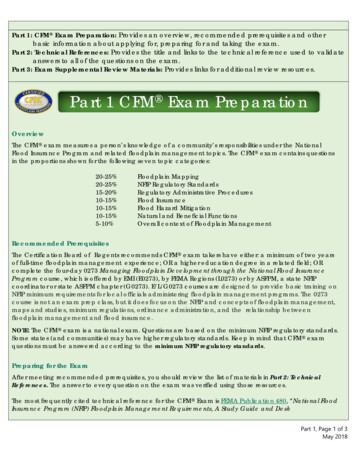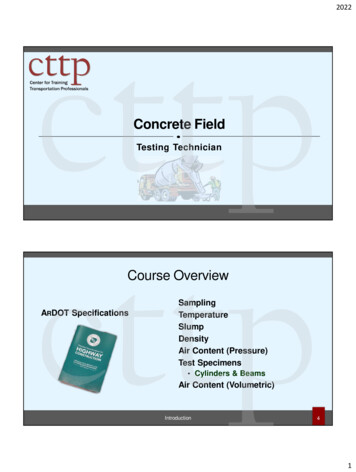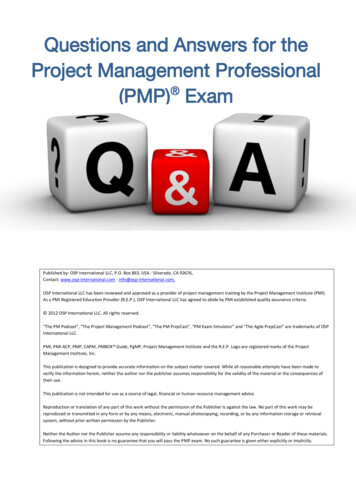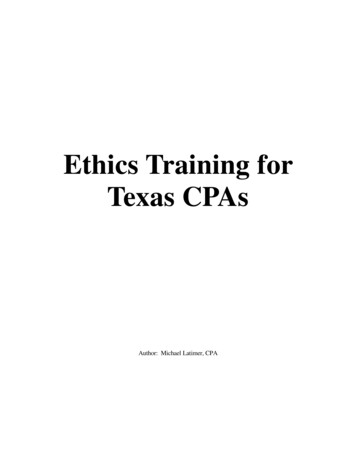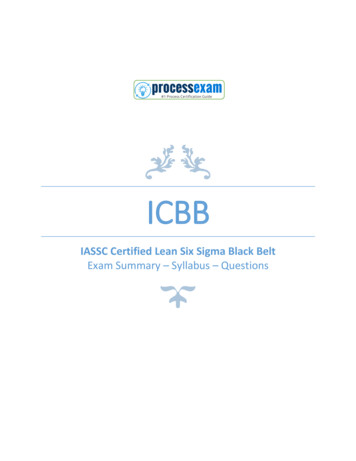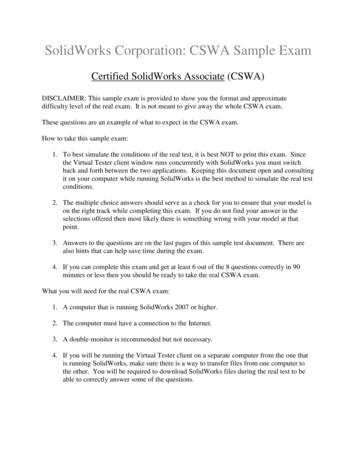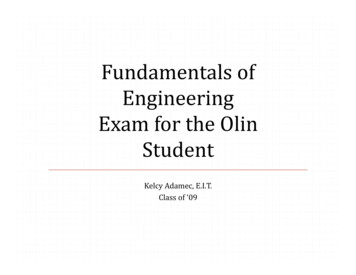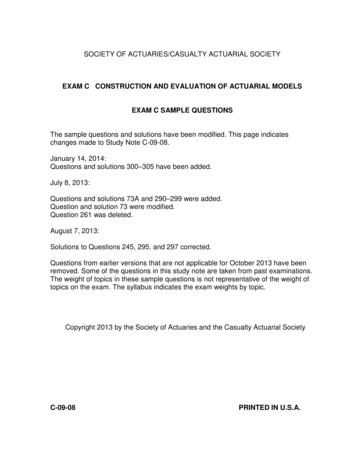
Transcription
SOCIETY OF ACTUARIES/CASUALTY ACTUARIAL SOCIETYEXAM C CONSTRUCTION AND EVALUATION OF ACTUARIAL MODELSEXAM C SAMPLE QUESTIONSThe sample questions and solutions have been modified. This page indicateschanges made to Study Note C-09-08.January 14, 2014:Questions and solutions 300–305 have been added.July 8, 2013:Questions and solutions 73A and 290–299 were added.Question and solution 73 were modified.Question 261 was deleted.August 7, 2013:Solutions to Questions 245, 295, and 297 corrected.Questions from earlier versions that are not applicable for October 2013 have beenremoved. Some of the questions in this study note are taken from past examinations.The weight of topics in these sample questions is not representative of the weight oftopics on the exam. The syllabus indicates the exam weights by topic.Copyright 2013 by the Society of Actuaries and the Casualty Actuarial SocietyC-09-08PRINTED IN U.S.A.
1.You are given:(i)Losses follow a loglogistic distribution with cumulative distribution function:bx / θ gF b xg 1 bx / θ gγγ(ii)The sample of losses is:10358086901201581802002101500Calculate the estimate of θ by percentile matching, using the 40th and 80th empiricallysmoothed percentile estimates.2.(A)Less than 77(B)At least 77, but less than 87(C)At least 87, but less than 97(D)At least 97, but less than 107(E)At least 107You are given:(i)The number of claims has a Poisson distribution.(ii)Claim sizes have a Pareto distribution with parameters θ 0.5 and α 6 .(iii)The number of claims and claim sizes are independent.(iv)The observed pure premium should be within 2% of the expected pure premium 90%of the time.Determine the expected number of claims needed for full credibility.(A)Less than 7,000(B)At least 7,000, but less than 10,000(C)At least 10,000, but less than 13,000(D)At least 13,000, but less than 16,000(E)At least 16,000-2-
3.You study five lives to estimate the time from the onset of a disease to death. The times todeath are:23337Using a triangular kernel with bandwidth 2, estimate the density function at 2.5.4.(A)8/40(B)12/40(C)14/40(D)16/40(E)17/40You are given:(i)Losses follow a single-parameter Pareto distribution with density function: f ( x)(ii)αx(α 1),x 1,0 α A random sample of size five produced three losses with values 3, 6 and 14, and twolosses exceeding 25.Determine the maximum likelihood estimate of α .(A)0.25(B)0.30(C)0.34(D)0.38(E)0.42-3-
5.You are given:(i)The annual number of claims for a policyholder has a binomial distribution withprobability function: 2 2 x p ( x q ) q x (1 q ) , x 0, 1, 2 x (ii)The prior distribution is:π ( q ) 4q 3 , 0 q 1This policyholder had one claim in each of Years 1 and 2.Determine the Bayesian estimate of the number of claims in Year 3.6.(A)Less than 1.1(B)At least 1.1, but less than 1.3(C)At least 1.3, but less than 1.5(D)At least 1.5, but less than 1.7(E)At least 1.7For a sample of dental claims x1, x2 , . . . , x10 , you are given:(i) and xi2 4,574,802 xi 3860(ii)Claims are assumed to follow a lognormal distribution with parameters µ and σ .(iii)µ and σ are estimated using the method of moments.Calculate E X 500 for the fitted distribution.(A)Less than 125(B)At least 125, but less than 175(C)At least 175, but less than 225(D)At least 225, but less than 275(E)At least 275-4-
7.8.DELETEDYou are given:(i)Claim counts follow a Poisson distribution with mean θ .(ii)Claim sizes follow an exponential distribution with mean 10θ .(iii)Claim counts and claim sizes are independent, given θ .(iv)The prior distribution has probability density function:5π θ 6 , θ 1bgθCalculate Bühlmann’s k for aggregate losses.(A)Less than 1(B)At least 1, but less than 2(C)At least 2, but less than 3(D)At least 3, but less than 4(E)At least 49.DELETED10.DELETED-5-
11.You are given:(i)Losses on a company’s insurance policies follow a Pareto distribution withprobability density function:f (xθ ) (ii)θ, 0 x 2( x θ )For half of the company’s policies θ 1 , while for the other half θ 3 .For a randomly selected policy, losses in Year 1 were 5.Determine the posterior probability that losses for this policy in Year 2 will exceed 8.12.(A)0.11(B)0.15(C)0.19(D)0.21(E)0.27You are given total claims for two 6254700750Using the nonparametric empirical Bayes method, determine the Bühlmann credibilitypremium for Policyholder Y.(A)655(B)670(C)687(D)703(E)719-6-
13.A particular line of business has three types of claims. The historical probability and thenumber of claims for each type in the current year Number of Claimsin Current Year112180138You test the null hypothesis that the probability of each type of claim in the current year isthe same as the historical probability.Calculate the chi-square goodness-of-fit test statistic.14.(A)Less than 9(B)At least 9, but less than 10(C)At least 10, but less than 11(D)At least 11, but less than 12(E)At least 12The information associated with the maximum likelihood estimator of a parameter θ is 4n ,where n is the number of observations.Calculate the asymptotic variance of the maximum likelihood estimator of 2θ .(A)1(B)1(C)4(D)8n(E)16n2nnn-7-
15.You are given:(i)The probability that an insured will have at least one loss during any year is p.(ii)The prior distribution for p is uniform on [ 0,0.5] .(iii)An insured is observed for 8 years and has at least one loss every year.Determine the posterior probability that the insured will have at least one loss during Year e the following information for questions 16 and 17.For a survival study with censored and truncated data, you are given:Time (t)1234516.Number at Riskat Time t3027322520Failures at Time t59654The probability of failing at or before Time 4, given survival past Time 1, is 3 q1 .Calculate Greenwood’s approximation of the variance of 3 q 1 .(A)0.0067(B)0.0073(C)0.0080(D)0.0091(E)0.0105-8-
17.18.bgCalculate the 95% log-transformed confidence interval for H 3 , based on the Nelson-Aalenestimate.(A)(0.30, 0.89)(B)(0.31, 1.54)(C)(0.39, 0.99)(D)(0.44, 1.07)(E)(0.56, 0.79)You are given:(i)Two risks have the following severity distributions:Amount of Claim2502,50060,000(ii)Probability of ClaimAmount for Risk 10.50.30.2Probability of ClaimAmount for Risk 20.70.20.1Risk 1 is twice as likely to be observed as Risk 2.A claim of 250 is observed.Determine the Bühlmann credibility estimate of the second claim amount from the same risk.(A)Less than 10,200(B)At least 10,200, but less than 10,400(C)At least 10,400, but less than 10,600(D)At least 10,600, but less than 10,800(E)At least 10,800-9-
19.You are given:(i)A sample x1 , x2 , , x10 is drawn from a distribution with probability density function:1 11f ( x ) e x /θ e x / σ2 θσ(ii)θ σ(iii) xi 150 and xi2 5000 , x 0Estimate θ by matching the first two sample moments to the corresponding u are given a sample of two values, 5 and 9.You estimate Var(X) using the estimator g(X1, X2) 1( X i X )2 . 2Determine the bootstrap approximation to the mean square error of g.(A)1(B)2(C)4(D)8(E)16- 10 -
21.You are given:(i)The number of claims incurred in a month by any insured has a Poisson distributionwith mean λ .(ii)The claim frequencies of different insureds are independent.(iii)The prior distribution is gamma with probability density function:f (λ ) (iv)Month1234(100λ )6 100 λe120λNumber of Insureds100150200300Number of Claims6811?Determine the Bühlmann-Straub credibility estimate of the number of claims in Month 4.(A)16.7(B)16.9(C)17.3(D)17.6(E)18.0- 11 -
22.You fit a Pareto distribution to a sample of 200 claim amounts and use the likelihood ratiotest to test the hypothesis that α 1.5 and θ 7.8 .You are given:(i)The maximum likelihood estimates are α 1.4 and θ 7.6.(ii)The natural logarithm of the likelihood function evaluated at the maximum likelihoodestimates is 817.92.(iii)607.64 ln ( xi 7.8) Determine the result of the test.(A)Reject at the 0.005 significance level.(B)Reject at the 0.010 significance level, but not at the 0.005 level.(C)Reject at the 0.025 significance level, but not at the 0.010 level.(D)Reject at the 0.050 significance level, but not at the 0.025 level.(E)Do not reject at the 0.050 significance level.- 12 -
23.For a sample of 15 losses, you are given:(i)(ii)Interval(0, 2]Observed Number ofLosses5(2, 5]5(5, )5b gLosses follow the uniform distribution on 0,θ .Estimate θ by minimizing the function3( E j Oj )j 1Oj 2, where E j is the expected number oflosses in the jth interval and O j is the observed number of losses in the jth interval.(A)6.0(B)6.4(C)6.8(D)7.2(E)7.6- 13 -
24.You are given:(i)The probability that an insured will have exactly one claim is θ .(ii)The prior distribution of θ has probability density function:bg3θ, 0 θ 12A randomly chosen insured is observed to have exactly one claim.πθ Determine the posterior probability that θ is greater than 0.60.25.(A)0.54(B)0.58(C)0.63(D)0.67(E)0.72The distribution of accidents for 84 randomly selected policies is as follows:Number of AccidentsNumber of Policies01234563226127421Total84Which of the following models best represents these data?(A)Negative binomial(B)Discrete uniform(C)Poisson- 14 -
26.(D)Binomial(E)Either Poisson or BinomialYou are given:(i)Low-hazard risks have an exponential claim size distribution with mean θ .(ii)Medium-hazard risks have an exponential claim size distribution with mean 2θ .(iii)High-hazard risks have an exponential claim size distribution with mean 3θ .(iv)No claims from low-hazard risks are observed.(v)Three claims from medium-hazard risks are observed, of sizes 1, 2 and 3.(vi)One claim from a high-hazard risk is observed, of size 15.Determine the maximum likelihood estimate of θ .(A)1(B)2(C)3(D)4(E)5- 15 -
27.You are given:(i)X partial pure premium calculated from partially credible data(ii)µ E X partial (iii)Fluctuations are limited to k µ of the mean with probability P(iv)Z credibility factorWhich of the following is equal to P?28.(A)Pr µ k µ X partial µ k µ (B)Pr Z µ k Z X partial Z µ k (C)Pr Z µ µ Z X partial Z µ µ (D)Pr 1 k Z X partial (1 Z ) µ 1 k (E)Pr µ k µ Z X partial (1 Z ) µ µ k µ You are given:Claim Size (X)b0, 25Number of Claims25b25, 5028b50, 10015b100, 2006Assume a uniform distribution of claim sizes within each interval.c h bgEstimate E X 2 E X 1502.- 16 -
29.(A)Less than 200(B)At least 200, but less than 300(C)At least 300, but less than 400(D)At least 400, but less than 500(E)At least 500You are given:(i)Each risk has at most one claim each year.(ii)Type of RiskIPrior Probability0.7Annual ClaimProbability0.1II0.20.2III0.10.4One randomly chosen risk has three claims during Years 1-6.Determine the posterior probability of a claim for this risk in Year 7.(A)0.22(B)0.28(C)0.33(D)0.40(E)0.46- 17 -
30.You are given the following about 100 insurance policies in a study of time to policysurrender:(i)The study was designed in such a way that for every policy that was surrendered, anew policy was added, meaning that the risk set, rj , is always equal to 100.(ii)Policies are surrendered only at the end of a policy year.(iii)The number of policies surrendered at the end of each policy year was observed to be:1 at the end of the 1st policy year2 at the end of the 2nd policy year3 at the end of the 3rd policy year n at the end of the nth policy year(iv)The Nelson-Aalen empirical estimate of the cumulative distribution function at timen, Fˆ (n) , is 0.542.What is the value of n?(A)831.(B)9(C)10(D)11(E)12You are given the following claim data for automobile policies:200 255 295 320 360 420 440 490 500 520 1020Calculate the smoothed empirical estimate of the 45th percentile.(A)358(B)371(C)384(D)390(E)396- 18 -
32.You are given:(i)The number of claims made by an individual insured in a year has a Poissondistribution with mean λ.(ii)The prior distribution for λ is gamma with parameters α 1 and θ 1.2 .Three claims are observed in Year 1, and no claims are observed in Year 2.Using Bühlmann credibility, estimate the number of claims in Year 3.33.(A)1.35(B)1.36(C)1.40(D)1.41(E)1.43In a study of claim payment times, you are given:(i)The data were not truncated or censored.(ii)At most one claim was paid at any one time.(iii)The Nelson-Aalen estimate of the cumulative hazard function, H(t), immediatelyfollowing the second paid claim, was 23/132.Determine the Nelson-Aalen estimate of the cumulative hazard function, H(t), immediatelyfollowing the fourth paid claim.(A)0.35(B)0.37(C)0.39(D)0.41(E)0.43- 19 -
34.The number of claims follows a negative binomial distribution with parameters β and r,where β is unknown and r is known. You wish to estimate β based on n observations,where x is the mean of these observations.Determine the maximum likelihood estimate of β .35.(A)xr2(B)xr(C)x(D)rx(E)r2xYou are given the following information about a credibility model:First Observation123Unconditional Probability1/31/31/3Bayesian Estimate ofSecond Observation1.501.503.00Determine the Bühlmann credibility estimate of the second observation, given that the firstobservation is 1.(A)0.75(B)1.00(C)1.25(D)1.50(E)1.75- 20 -
36.For a survival study, you are given:(i)bgThe product-limit estimator S t0 is used to construct confidence intervals forbgS t0 .bg b(ii)gThe 95% log-transformed confidence interval for S t0 is 0.695, 0.843 .bgDetermine S t0 .(A) 0.758(B) 0.762(C) 0.765(D) 0.769(E) 0.77937.A random sample of three claims from a dental insurance plan is given below:225525950Claims are assumed to follow a Pareto distribution with parameters θ 150 and α .Determine the maximum likelihood estimate of α .(A)Less than 0.6(B)At least 0.6, but less than 0.7(C)At least 0.7, but less than 0.8(D)At least 0.8, but less than 0.9(E)At least 0.9- 21 -
38.An insurer has data on losses for four policyholders for 7 years. The loss from the i thpolicyholder for year j is X ij .You are given: d X ij X i i472 33.60i 1 j 1 c Xi X h42 3.30i 1Using nonparametric empirical Bayes estimation, calculate the Bühlmann credibility factorfor an individual policyholder.39.(A)Less than 0.74(B)At least 0.74, but less than 0.77(C)At least 0.77, but less than 0.80(D)At least 0.80, but less than 0.83(E)At least 0.83You are given the following information about a commercial auto liability book of business:(i)Each insured’s claim count has a Poisson distribution with mean λ , where λ has agamma distribution with α 15. and θ 0.2 .(ii)Individual claim size amounts are independent and exponentially distributed withmean 5000.(iii)The full credibility standard is for aggregate losses to be within 5% of the expectedwith probability 0.90.Using classical credibility, determine the expected number of claims required for fullcredibility.- 22 -
40.(A)2165(B)2381(C)3514(D)7216(E)7938You are given:(i)A sample of claim payments is:296490135182(ii)Claim sizes are assumed to follow an exponential distribution.(iii)The mean of the exponential distribution is estimated using the method of moments.Calculate the value of the Kolmogorov-Smirnov test u are given:(i)Annual claim frequency for an individual policyholder has mean λ and variance σ 2 .(ii)The prior distribution for λ is uniform on the interval [0.5, 1.5].(iii)The prior distribution for σ 2 is exponential with mean 1.25.A policyholder is selected at random and observed to have no claims in Year 1.Using Bühlmann credibility, estimate the number of claims in Year 2 for the selectedpolicyholder.- 23 -
u are given:(i)The prior distribution of the parameter Θ has probability density function:bgπθ (ii)1, 1 θ θ2Given Θ θ , claim sizes follow a Pareto distribution with parameters α 2 and θ .A claim of 3 is observed.Calculate the posterior probability that Θ exceeds 2.(A)0.33(B)0.42(C)0.50(D)0.58(E)0.64- 24 -
44.You are given:(i)Losses follow an exponential distribution with mean θ .(ii)A random sample of 20 losses is distributed as follows:Loss RangeFrequency[0, 1000]7(1000, 2000]6(2000, )7Calculate the maximum likelihood estimate of θ .45.(A)Less than 1950(B)At least 1950, but less than 2100(C)At least 2100, but less than 2250(D)At least 2250, but less than 2400(E)At least 2400You are given:(i)The amount of a claim, X, is uniformly distributed on the interval 0,θ .(ii)The prior density of θ is π θ bg500θ2, θ 500 .Two claims, x1 400 and x2 600 , are observed. You calculate the posteriordistribution as:I , θ 600h FGH 600θ JKCalculate the Bayesian premium, Ec X x , x h .c3f θ x1 , x2 34312- 25 -
46.(A)450(B)500(C)550(D)600(E)650The claim payments on a sample of ten policies are:2335 567 79 10 indicates that the loss exceeded the policy limitUsing the product-limit estimator, calculate the probability that the loss on a policyexceeds 8.(A)0.20(B)0.25(C)0.30(D)0.36(E)0.40- 26 -
47.You are given the following observed claim frequency data collected over a period of 365days:Number of Claims per Day01234 Observed Number of Days50122101920Fit a Poisson distribution to the above data, using the method of maximum likelihood.Regroup the data, by number of claims per day, into four groups:0123 Apply the chi-square goodness-of-fit test to evaluate the null hypothesis that the claimsfollow a Poisson distribution.Determine the result of the chi-square test.(A)Reject at the 0.005 significance level.(B)Reject at the 0.010 significance level, but not at the 0.005 level.(C)Reject at the 0.025 significance level, but not at the 0.010 level.(D)Reject at the 0.050 significance level, but not at the 0.025 level.(E)Do not reject at the 0.050 significance level.- 27 -
48.You are given the following joint distribution:Θ010.40.10.10.10.20.1X012For a given value of Θ and a sample of size 10 for X:10 xi 10i 1Determine the Bühlmann credibility premium.49.(A)0.75(B)0.79(C)0.82(D)0.86(E)0.89You are given:x0123Pr[X x]0.50.30.10.1The method of moments is used to estimate the population mean, µ , and variance, σ 2 ,by X and S2n ( X i X)n2, respectively.Calculate the bias of Sn2 , when n 4.- 28 -
You are given four classes of insureds, each of whom may have zero or one claim, with thefollowing probabilities:ClassNumber of Claims01I0.90.1II0.80.2III0.50.5IV0.10.9A class is selected at random (with probability ¼), and four insureds are selected at randomfrom the class. The total number of claims is two.If five insureds are selected at random from the same class, estimate the total number ofclaims using Bühlmann-Straub ED- 29 -
52.53.With the bootstrapping technique, the underlying distribution function is estimated by whichof the following?(A)The empirical distribution function(B)A normal distribution function(C)A parametric distribution function selected by the modeler(D)Any of (A), (B) or (C)(E)None of (A), (B) or (C)You are given:Number ofClaims012Probability131Claim Size55525115025022001Claim sizes are independent.Determine the variance of the aggregate obability- 30 -3333
54.You are given:(i)Losses follow an exponential distribution with mean θ .(ii)A random sample of losses is distributed as follows:Loss RangeNumber of Losses(0 – 100]32(100 – 200]21(200 – 400]27(400 – 750]16(750 – 1000]2(1000 – 1500]2Total100Estimate θ by matching at the 80th percentile.55.(A)249(B)253(C)257(D)260(E)263You are given:Class123Number ofInsureds300020001000Claim Count Probabilities012111300136021336340001263A randomly selected insured has one claim in Year 1.Determine the expected number of claims in Year 2 for that insured.- 31 -16
56.(A)1.00(B)1.25(C)1.33(D)1.67(E)1.75You are given the following information about a group of policies:Claim PaymentPolicy Limit5501550601001001005005005001000Determine the likelihood function.(A)f(50) f(50) f(100) f(100) f(500) f(1000)(B)f(50) f(50) f(100) f(100) f(500) f(1000) / [1-F(1000)](C)f(5) f(15) f(60) f(100) f(500) f(500)(D)f(5) f(15) f(60) f(100) f(500) f(500) / [1-F(1000)](E)f(5) f(15) f(60) [1-F(100)] [1-F(500)] f(500)- 32 -
57.You are given:Claim SizeNumber of Claims0-253025-503250-10020100-2008Assume a uniform distribution of claim sizes within each interval.Estimate the second raw moment of the claim size distribution.58.(A)Less than 3300(B)At least 3300, but less than 3500(C)At least 3500, but less than 3700(D)At least 3700, but less than 3900(E)At least 3900You are given:(i)The number of claims per auto insured follows a Poisson distribution with mean λ .(ii)The prior distribution for λ has the following probability density function:b g b500λλΓgb50e gf λ (iii)50 500 λA company observes the following claims experience:Number of claimsNumber of autos insuredYear 175600The company expects to insure 1100 autos in Year 3.Determine the expected number of claims in Year 3.- 33 -Year 2210900
59.(A)178(B)184(C)193(D)209(E)224The graph below shows a p-p plot of a fitted distribution compared to a sample.FittedSampleWhich of the following is true?(A)The tails of the fitted distribution are too thick on the left and on the right, and thefitted distribution has less probability around the median than the sample.(B)The tails of the fitted distribution are too thick on the left and on the right, and thefitted distribution has more probability around the median than the sample.(C)The tails of the fitted distribution are too thin on the left and on the right, and thefitted distribution has less probability around the median than the sample.(D)The tails of the fitted distribution are too thin on the left and on the right, and thefitted distribution has more probability around the median than the sample.(E)The tail of the fitted distribution is too thick on the left, too thin on the right, and thefitted distribution has less probability around the median than the sample.- 34 -
60.You are given the following information about six coins:Coin1–456Probability of Heads0.500.250.75A coin is selected at random and then flipped repeatedly. X i denotes the outcome of the ithflip, where “1” indicates heads and “0” indicates tails. The following sequence is obtained:lq lqS X 1 , X 2 , X 3 , X 4 11, ,0,1c hDetermine E X 5 S using Bayesian analysis.61.(A)0.52(B)0.54(C)0.56(D)0.59(E)0.63You observe the following five ground-up claims from a data set that is truncated from belowat 100:125150165175250You fit a ground-up exponential distribution using maximum likelihood estimation.Determine the mean of the fitted distribution.(A)73(B)100(C)125(D)156(E)173- 35 -
62.An insurer writes a large book of home warranty policies. You are given the followinginformation regarding claims filed by insureds against these policies:(i)A maximum of one claim may be filed per year.(ii)The probability of a claim varies by insured, and the claims experience for eachinsured is independent of every other insured.(iii)The probability of a claim for each insured remains constant over time.(iv)The overall probability of a claim being filed by a randomly selected insured in a yearis 0.10.(v)The variance of the individual insured claim probabilities is 0.01.An insured selected at random is found to have filed 0 claims over the past 10 years.Determine the Bühlmann credibility estimate for the expected number of claims the selectedinsured will file over the next 5 D64.For a group of insureds, you are given:(i)The amount of a claim is uniformly distributed but will not exceed a certain unknownlimit θ .(ii)The prior distribution of θ is π θ (iii)Two independent claims of 400 and 600 are observed.bg500θ2, θ 500 .Determine the probability that the next claim will exceed 550.- 36 -
65.(A)0.19(B)0.22(C)0.25(D)0.28(E)0.31You are given the following information about a general liability book of business comprisedof 2500 insureds:Ni(i)X i Yij is a random variable representing the annual loss of the ith insured.j 1(ii)N1, N 2 , ., N 2500 are independent and identically distributed random variablesfollowing a negative binomial distribution with parameters r 2 and β 0.2.(iii)Yi1, Yi 2 , ., YiN i are independent and identically distributed random variables followinga Pareto distribution with α 3.0 and θ 1000 .(iv)The full credibility standard is to be within 5% of the expected aggregate losses 90%of the time.Using classical credibility theory, determine the partial credibility of the annual lossexperience for this book of business.(A)0.34(B)0.42(C)0.47(D)0.50(E)0.53- 37 -
66.To estimate E X , you have simulated X 1 , X 2 , X 3 , X 4 and X 5 with the following results:12345You want the standard deviation of the estimator of E X to be less than 0.05.Estimate the total number of simulations needed.67.(A)Less than 150(B)At least 150, but less than 400(C)At least 400, but less than 650(D)At least 650, but less than 900(E)At least 900You are given the following information about a book of business comprised of 100 insureds:Ni(i)X i Yij is a random variable representing the annual loss of the i th insured.j 1(ii)N1, N 2 , . , N100 are independent random variables distributed according to a negativebinomial distribution with parameters r (unknown) and β 0.2.(iii)Unknown parameter r has an exponential distribution with mean 2.(iv)Yi1, Yi 2 , ., YiN i are independent random variables distributed according to a Paretodistribution with α 3.0 and θ 1000 .Determine the Bühlmann credibility factor, Z, for the book of business.(A)0.000(B)0.045(C)0.500(D)0.826(E)0.905- 38 -
68.For a mortality study of insurance applicants in two countries, you are given:(i)Country ACountry 121045bbt , t g are assumed to occur at t .S bt g is the product-limit estimate of S bt g based on the data for all studyi 1 i(iii)grj is the number at risk over the period ti 1 , ti . Deaths, S j , during the periodiTparticipants.(iv)bgbgS B t is the product-limit estimate of S t based on the data for study participants inCountry B.bgbgDetermine S T 4 S B 4 .69.(A)0.06(B)0.07(C)0.08(D)0.09(E)0.10You fit an exponential distribution to the following data:10001400530074007600Determine the coefficient of variation of the maximum likelihood estimate of the mean, θ .- 39 -
70.(A)0.33(B)0.45(C)0.70(D)1.00(E)1.21You are given the following information on claim frequency of automobile accidents forindividual drivers:RuralBusiness UseExpectedClaimClaimsVariance1.00.5Pleasure 1.0Total1.81.062.31.12You are also given:(i)Each driver’s claims experience is independent of every other driver’s.(ii)There are an equal number of business and pleasure use drivers.Determine the Bühlmann credibility factor for a single driver.(A)0.05(B)0.09(C)0.17(D)0.19(E)0.27- 40 -
71.You are investigating insurance fraud that manifests itself through claimants who file claimswith respect to auto accidents with which they were not involved. Your evidence consists ofa distribution of the observed number of claimants per accident and a standard distributionfor accidents on which fraud is known to be absent. The two distributions are summarizedbelow:Number of Claimantsper Accident123456 TotalStandard Probability0.25.35.24.11.04.011.00Observed Number ofAccidents23533525011147221000Determine the result of a chi-square test of the null hypothesis that there is no fraud in theobserved accidents.(A)Reject at the 0.005 significance level.(B)Reject at the 0.010 significance level, but not at the 0.005 level.(C)Reject at the 0.025 significance level, but not at the 0.010 level.(D)Reject at the 0.050 significance level, but not at the 0.025 level.(E)Do not reject at the 0.050 significance level.- 41 -
72.You are given the following data on large business policyholders:(i)Losses for each employee of a given policyholder are independent and have acommon mean and variance.(ii)The overall average loss per employee for all policyholders is 20.(iii)The variance of the hypothetical means is 40.(iv)The expected value of the process variance is 8000.(v)The following experience is observed for a randomly selected policyholder:Year123Average Loss perEmployee15105Number ofEmployees800600400Determine the Bühlmann-Straub credibility premium per employee for this policyholder.(A)Less than 10.5(B)At least 10.5, but less than 11.5(C)At least 11.5, but less than 12.5(D)At least 12.5, but less than 13.5(E)At least 13.5- 42 -
73.You are given the following information about a group of 10 claims:Claim SizeInterval(0-15,000]Number of Claimsin Interval1Number of ClaimsCensored in Interval2(15,000-30,000]12(30,000-45,000]40Assume that claim sizes and censorship points are uniformly distributed within each interval.Estimate, using large data set methodology and exact exposures, the probability that a claimexceeds 30,000.(A)0.67(B)0.70(C)0.74(D)0.77(E)0.8073A. You are given the following information about a group of 10 claims:Claim SizeInterval(0-15,000]Number of Claimsin Interval1Number of ClaimsCensored in Interval2(15,000-30,000]12(30,000-45,000]40Assume that claim sizes and censorship points are uniformly distributed within each interval.Estimate, using large data set methodology and actuarial exposures, the probability that aclaim exceeds 30,000.- 43 -
u are given:(i)Claim amounts follow a shifted exponential distribution with probability densityfunction:1f x e b x δ g/θ , δ x bg(ii)θA random
EXAM C CONSTRUCTION AND EVALUATION OF ACTUARIAL MODELS . EXAM C SAMPLE QUESTIONS . The sample questions and solutions have been modified. This page indicates changes made to Study Note C-09-08. January 14, 2014: . The sample of losses is: 10 35 80 86 90 120 158 180 200 210 1500 . Calculate the estimate of . θ by percentile matching, .
